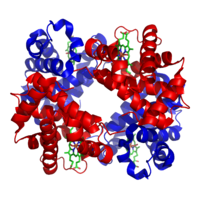
Photo from wikipedia
Hemoconcentration during exercise is a well-known phenomenon, however, the extent to which dehydration is involved is unclear. In our study, the effect of dehydration on exercise-induced hemoconcentration was examined in… Click to show full abstract
Hemoconcentration during exercise is a well-known phenomenon, however, the extent to which dehydration is involved is unclear. In our study, the effect of dehydration on exercise-induced hemoconcentration was examined in 12 elite Hungarian kayak-canoe athletes. The changes of blood markers were examined during acute maximal workload in hydrated and dehydrated states. Dehydration was achieved by exercise, during a 120-minute extensive-aerobic preload. Our research is one of the first studies in which the changes in blood components were examined with a higher time resolution and a wider range of the measured parameters. Hydration status had no effect on the dynamics of hemoconcentration during both the hydrated (HS) and dehydrated (DHS) load, although lower maximal power output were measured after the 120-minute preload [HS Hemoglobin(Hgb)Max median 17.4 (q1 17.03; q3 17.9) g/dl vs. DHS HgbMax median 16.9 (q1 16.43; q3 17.6) g/dl (n.s); HS Hematocrit(Hct)Max 53.50 (q1 52.28; q3 54.8) % vs. DHS HctMax 51.90 (q1 50.35; q3 53.93) % (n.s)]. Thirty minutes after the maximal loading, complete hemodilution was confirmed in both exercises. Dehydration had no effect on hemoconcentration or hemodilution in the recovery period [HS HgbR30’ 15.7 (q1 15.15; q3 16.05) g/dl (n.s.) vs. DHS HgbR30’ 15.75 (q1 15.48; q3 16.13) g/dl (n.s.), HS HctR30’ 48.15 (q1 46.5; q3 49.2) % vs. DHS HctR30’ 48.25 (q1 47.48; q3 49.45) % (n.s.)], however, plasma osmolality did not follow a corresponding decrease in hemoglobin and hematocrit in the dehydrated group. Based on our data, metabolic products (glucose, lactate, sodium, potassium, chloride, bicarbonate ion, blood urea nitrogen) induced osmolality may not play a major role in the regulation of hemoconcentration and post-exercise hemodilution. From our results, we can conclude that hemoconcentration depends mainly on the intensity of the exercise.
Journal Title: PLOS ONE
Year Published: 2022
Link to full text (if available)
Share on Social Media: Sign Up to like & get
recommendations!